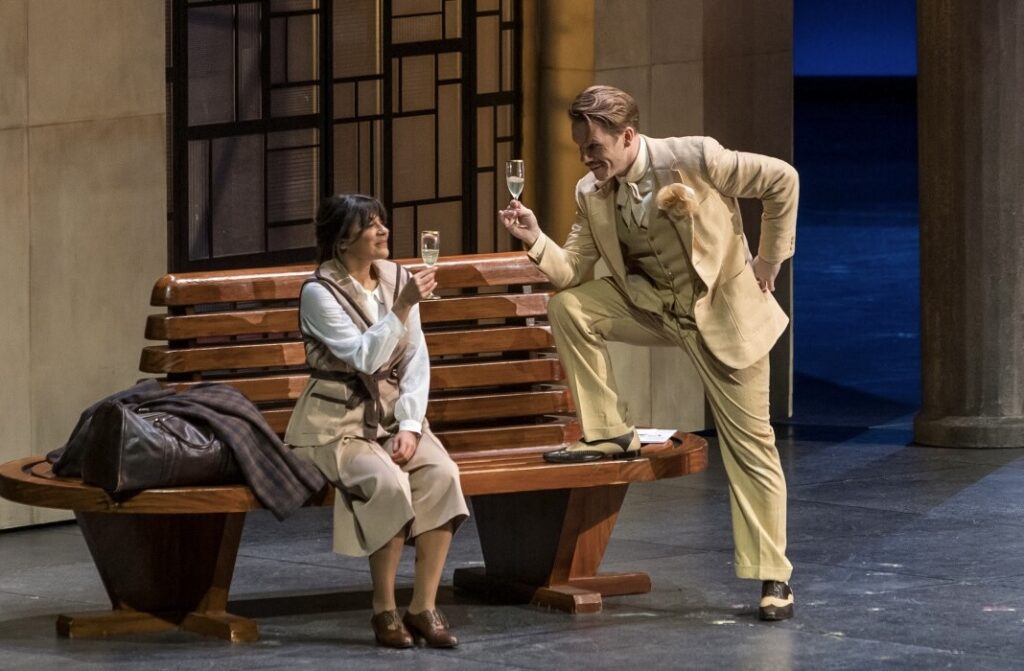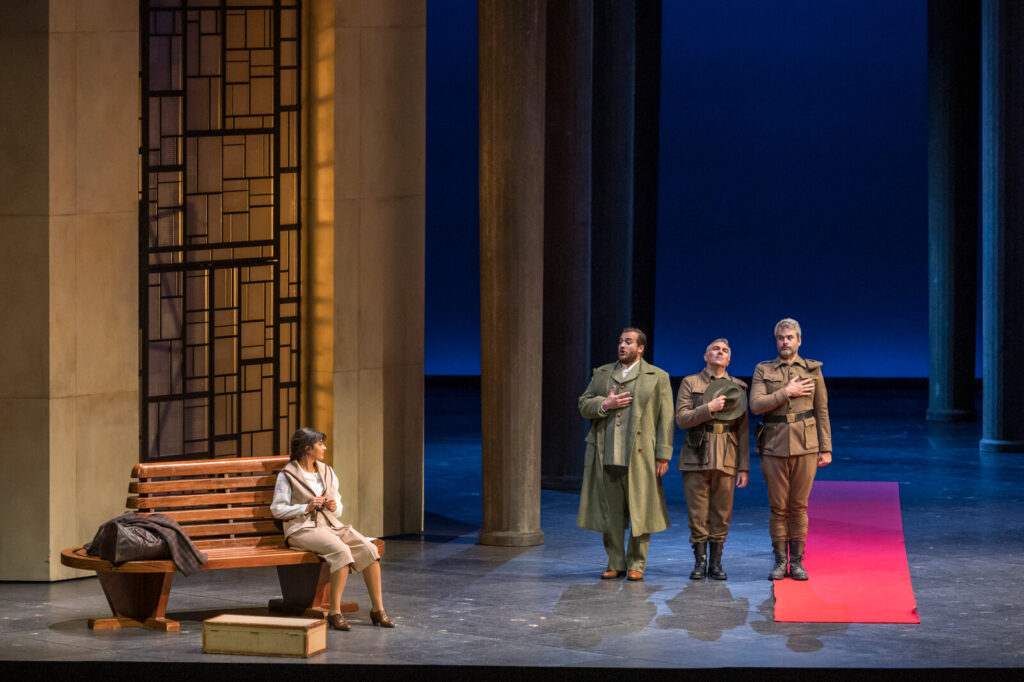Les années folles in France [the roaring twenties in the USA] brought dancer Josephine Baker to Paris with her Bal Negre. In more recent times, the 2020 the Covid infection allowed only four performances of Vincent Huguet production of Massenet’s Manon at the Opéra Bastille — there were fourteen scheduled performances.
Spring 2025 has brought the revival of Mr. Huguet’s production that imposes les années folles, and specifically dancer Josephine Baker onto Abbe Prévost’s 1731 novel, L’histoire du chevalier des Grieux et Manson Lescaut in the form of Jules Massenet’s 1884 opera, now titled simply Manon.
Back in 2020 San Francisco finished, Egyptian soprano Amina Edris had sung two of the four Paris performances, in this 2025 run she sings three of the eight, sharing the stage with tenor Roberto Alagna. Given this 62 year old tenor’s overwhelming stature Massenet’s opera could easily have reassumed the title of the famed 18th century novel (lead photo, with Act V soldiers).
Just now in Paris Mr. Alagna did sing all the notes Massenet assigned his tenor, and acted the role with all the panache of a famous tenor. His voice no longer has the bright edge and golden sheen heard on his 2000 recording of the opera (with his then wife Angelina Gheorghiu). The famed tenor does certainly still know how to take the stage, and remain the center of attention. His performance earned him this audience’s great esteem, his performance hardly a succès d’esteem.
Soprano Amina Edris did not pair effectively with Mr. Alagna, given the difference of age and size of voices. Mlle. Edris is a very accomplished singer. Of rich, ample and supple voice, as Manon she does not offer the brightness of voice often associated with this lyric coloratura role, nor at the performance I attended (June 17) did she have easy access to the many above the staff notes that define the role, flatting them slightly in the famed Gavotte, and holding their climactic moments only briefly.

The Vincent Huguet production demands a flashy Manon, a very flashy Manon, making demands that are perhaps impossible to fulfill. Mlle. Edris effectively portrayed the first act’s flightiness of a naive, provincial maiden with lively imagination and thwarted aspiration. Manon was then asked to magically transform herself in an interpolated scene in front of the curtain (to a scratchy 1920’s recording), into a Josephine Baker double, this by imitating the caricatured dance movements made by an exaggeration of Josephine Baker (a drag queen?). Manon was then shadowed for the duration of the opera by a Josephine Baker, played by actress Danielle Gabou.
The Vincent Huguet production was further hindered by the comparative youth and flash of Guillot de Morfontaine, hardly the Abbe Prévost and Massenet’s rich, dirty old man. This role was sung by Nicholas Jones, Guillot’s lively courtesans (Poussette, Javotte, and Rosette) were sung by members of the Paris Opera young artist program, and Guillot’s friend De Bretigny, was sung by Régis Mengus — who liked to appear in various disguises (as a nun in Act II, in falsetto!). All these characters were meant to impersonate an imagined, flashy beau monde for les années folles, of which Manon was now a member in high standing.
This is where a Manon of brilliant coloratura would shine. Though of rich tone, the tentative voice of Mlle. Edris left us a bit befuddled by the needs of the story. The lack of presence for Mr. Huget’s beau monde Manon can as well be attributed to the lighting, credited to Christophe Corey, that often left faces in the shadows, and the costumes, attributed to Clémence Pernoud, that confused us by duplications of female principals dressed as men in formal attire.
Mlle. Edris found her way again in the opera’s final scene, her voice shone in her duet with des Grieux, accepting blame for the bleak and unhappy outcome of her infatuation with the young, handsome, rich gallant who had saved her from a cloistered, convent life.
Massenet’s Manon is a big opera. Mr. Huguet and his designer, Auréle Maestre obliged with big scenery, meant to evoke the atmosphere’s of the 1920’s rather than create any specific locales. The first act was the most detailed, creating some sort of public space, complete with an elevated shadow box where an initial tryst was imagined. In Act II there was no petite table, but there were two huge, crated sculptures. Act IV had knock-offs of Cezanne and Picasso paintings on the wall, Act V was nothing more than the silhouettes of young women awaiting deportation and a weird hieroglyph on a wall.

Manon’s guardian Lescaut was sung by Polish baritone Andrzej Filończyk in incisive voice, proving his beau monde presence by assuming a lecherous attitude toward Manon. The Chevalier des Grieux’s father, the Count des Grieux was sung by Nicolas Cavallier.
The lack of any persuasive focus of the production rendered the pit ineffective. The maestro, Pierre Dumoussaud, was unable to alone salvage the magic of Massenet’s opera.
Michael Milenski
Opéra Bastille, Paris, France, June 17, 2025
All photos copyright Sebastien Mathé, courtesy of the Opéra National de Paris.